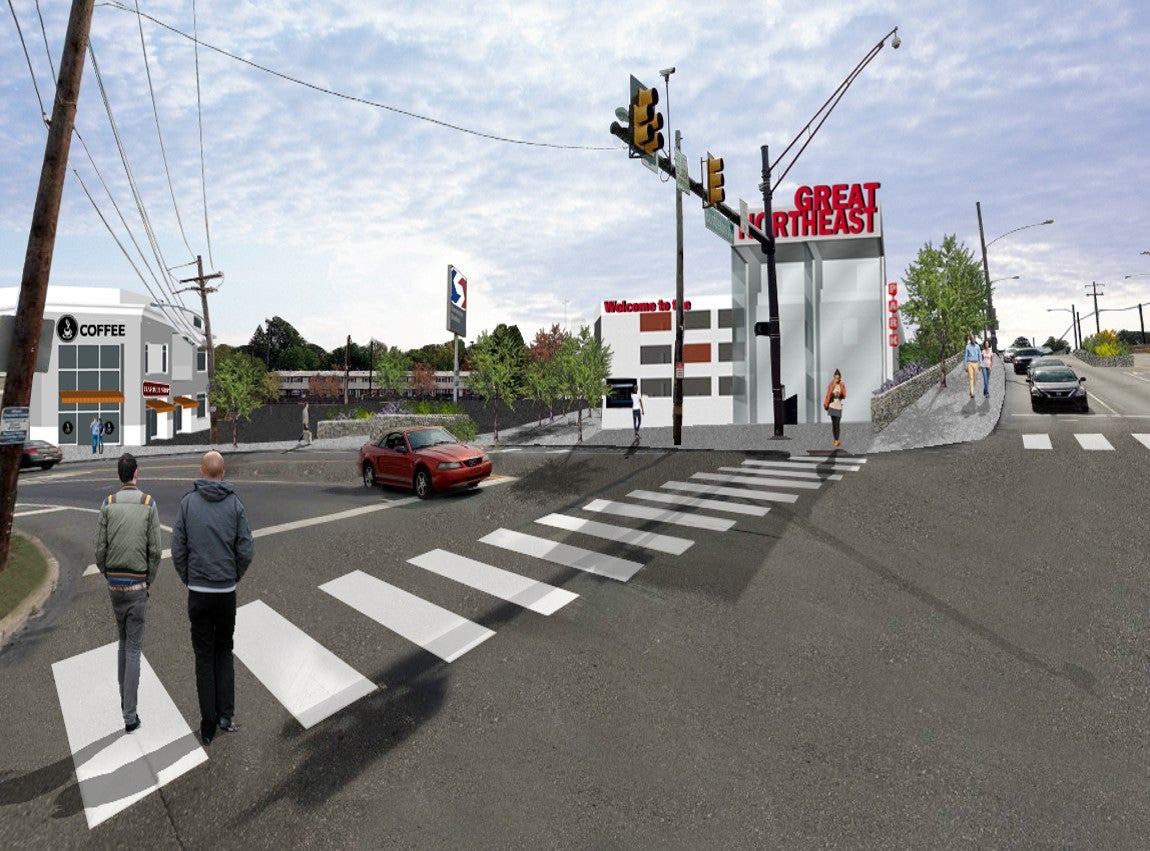District plan aims to make Far Northeast more pedestrian friendly

At the February meeting of the Philadelphia Planning Commission, the draft district plan for the Far Northeast made its debut. The proposal focuses on making three key areas in the auto-centric area more pedestrian friendly. These include the two regional rail stations on the West Trenton line, Forest Hills and Somerton, and on an older corner of Bustleton near Pennypack Park.
The Far Northeast is one of the few corners of the city largely developed after World War II, with fewer sidewalks and less dense residential development than found in the rest of the city. At the three meetings held to get citizen feedback on the district plan, community membrs expressed a desire for modest changes to this status quo.
“At our first public meeting, we asked the public if they would prefer a town center or more auto oriented shopping center,” said planning staffer Greg Waldman, in reference to future plans for Bustleton. “Residents overwhelmingly voted for the town center.”

The town center proposal demonstrates the challenges faced by Waldman, the planner in charge of the process. The area, centered on Grant Avenue and Bustleton Avenue, used to be Lower Moreland Township, before the municipality got absorbed by the city of Philadelphia during the 1854 consolidation. That makes it one of the oldest sections of the Far Northeast, with some infrastructure and buildings that date back to the Colonial era.
But in more recent years the area became populated with businesses specializing in automobile sale and repair. The sidewalks are cracked and pitted and the frequent curb cuts make walking difficult.
The Far Northeast District Plan would remake the area, to the extent possible. Proposals include designating historic resources (while specific targets aren’t mentioned, possibilities include St. Luke’s Memorial Episcopal Church and the Victorian-era buildings that dot the neighborhood). Pedestrian conditions would be improved by enhancing the streetscape with landscaping and street furniture. Pedestrian crossings at specific intersections, like Grant and Bustleton or Grant and Walsh would have their striping updated. Sidewalks at these sites would be expanded into the street to make the pedestrian experience safer.
Most significant would be the erection of a large mall—what Waldman calls a town center—in what is now a vacant lot at the northwest intersection of Grant and Bustleton. At its center, would be the relocated Welsh Library, which is currently a few blocks away below Roosevelt Boulevard.
The Far Northeast plan also seeks to transform the region’s two regional rail stops, which are clustered in the extreme northwest of the district. Although the Somerton and Forest Hills stop are a mere half mile from each other both are heavily used. Their parking lots are at capacity by 8:00 AM, leaving commuters to park their cars on the surrounding streets.
The refurbished Somerton stop, which is further north, would see its current parking capacity greatly expanded by the addition of multi-floor parking garage with 300-space capacity.
“Somerton is more of a gateway to the Great Northeast due to its proximity to the county line,” said Waldman. “Due to its designation as a gateway to the Far Northeast we also looked at installing gateway treatments.”
Renderings make clear what this means: An actual sign at the mouth of the parking area reading “Welcome To The Great Northeast.”
A few other new proposals ring the station, including a new mixed-use building across from the new sign (where a Wawa now stands). A couple other commercial buildings are proposed on Bustleton and Philmont.
By contrast with Somerton Station, Forest Hills station is considered a neighborhood hub due to its density of residential uses. (The census tracts surrounding it have unusually high transit usage in comparison with the rest of the Far Northeast, and the same is true of Somerton although adjacent residential uses there are fewer.) There are currently few commercial uses near the Forest Hills station.
The new proposal would seek to enhance the area by installing new mixed use buildings along Byberry Road, thus encouraging transit oriented development—and some commercial uses–at the few other underutilized patches nearby.
Waldman highlighted a couple others projects that didn’t quite reach “focus area” status, including a greening plan for the Northeast Shopping Center. This course would also make the antiquated commercial strip more pedestrian friendly, the recurring theme of the Far Northeast Plan’s action items. It seems that even Philadelphia’s most auto-centric region wants to stretch its legs a bit.

WHYY is your source for fact-based, in-depth journalism and information. As a nonprofit organization, we rely on financial support from readers like you. Please give today.







